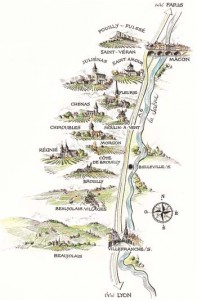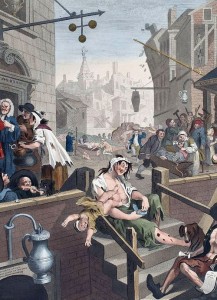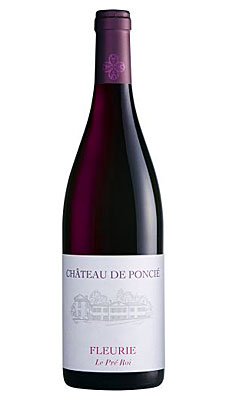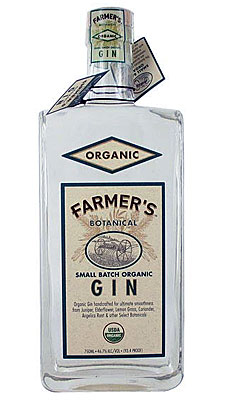Today let’s take an affectionate look at two beverages that have suffered from seriously poor reputations over time but that, at least among those who know them, have regained their appeal and become desirable again.
Wine Grape
Varietal Table
Remember studying the Periodic Table of the Elements in high school? You won’t need to struggle with Steve and Deborah De Long’s Wine Grape Varietal Table.
Browse the world’s ten best value wines on Wine-Searcher.com!
I’m talking about Beaujolais, and I’m talking about gin.
Beaujolais? Its lackluster reputation goes back a very long way, as far back as the 14th century, when Duke Philip the Bold of Burgundy so despised the Gamay grape that he outlawed it in Bourgogne in 1395, ordering Gamay vines ripped out by the roots and replaced with the more desirable Pinot Noir.
But Philip’s edict didn’t apply in the natural home of Beaujolais, a then-forgotten backwater well to the south of Burgundy’s more favored climes. Beaujolais vine growers never stopped making wine from Gamay, but for the next 500 years and more, Beaujolais toiled in isolated, rural poverty because hardly anyone (except, perhaps the thirsty gourmands in nearby Lyon) had much use for the wine.
It was only in the middle of the 20th century, after World War II, that the wine maker and marketing genius Georges Duboeuf rehabilitated Beaujolais, making it in large quantities and publicizing it across France, and eventually worldwide, with the annual spectacle of Beaujolais Nouveau. Shipping out the first new wine of the vintage only months after the grapes were picked, Duboeuf reaped vast publicity for his company and the wine.
But Nouveau’s star eventually began to fade, and I’m guessing that when the third week of November rolls around next month, most of us won’t even think about Beaujolais, much less buy a bottle. In fact, when was the last time you bought a bottle of any kind of Beaujolais?
But here’s the good news: As it was then, so it is now. Across the rolling hills of Beaujolais country, smaller producers – and some large ones, too – have continued squeezing the best out of the Gamay grape. The 10 villages considered best have earned the right to place the village name on the label rather than “Beaujolais,” perhaps tacitly expressing the reality that the name Beaujolais is not a selling point on a wine label. These wines, particularly in good vintages, show a depth, subtlety and complexity that you’ll rarely find in plain Beaujolais; and depending on cellar conditions, they can even improve with a few years of age.
Look for these names, listed geographically in order from north to south: St-Amour, Juliénas, Chénas, Moulin-a-Vent, Fleurie, Chiroubles, Morgon, Régnié, Brouilly, and Côte de Brouilly. For this week’s tasting (see below) I enjoyed a stylish Fleurie, Château de Poncie 2015 “Le Prê Roi.”
While we’re here, let’s take a quick look at gin, the juniper-scented, grain-based liquor that emerged from Holland (as “Jenever,” from the Dutch word for juniper) in the 16th century. When England summoned King William III and Queen Mary II from the Netherlands to succeed King James in 1689, they quickly encouraged Britons to make gin – which had already become popular in England – the national drink, creating a large market that they hoped would benefit both countries.
Unfortunately, according to a fascinating article about gin on Drinking Cup, a not-for-profit website designed to help share information and inspiration on the industry and subject of drink, this benignly intended influence of William’s reign “would lead to almost 60 years of unprecedented societal degradation.”
In a fascinating article, Gin Epidemic, Madam Geneva brings madness to England, Drinking Cup summarizes what happened next.
By 1721 English Excise and Revenue accounts noted that approximately one quarter of London’s residents were employed in the production of gin, equating for almost 2 million gallons (9.1 million litres) of tax free product a year. Over the following decade, gin consumption (by the average adult over the age of 15) would double again and the cities half a million population would be able to purchase a dram of gin for little more than a penny at a choice of almost 7000 gin shops. Naturally the major cities in England began to fall into a “well-documented drunken stupor”.
A 1736 pamphlet from some of the teetotal minority entitled, Distilled Liquors: The Bane of the Nation mentioned …
“In one place not far from East Smithfield, a trader has a large empty room where, as his wretched guests get intoxicated, they are laid together in heaps, men women and children, until they recover their senses, when they proceed to drink on, or having spent all they had, go out to find the means to return to the same dreadful pursuit.”
That’s not a pretty sight, and Americans may have remembered gin’s sketchy reputation when, during Prohibition, some of the nastiest, cheapest bottles of homemade liquor gained the moniker “bathtub gin.”
Nevertheless, quality gin eventually prevailed, and its affinity with vermouth and other mixers soon ensured the enduring popularity of the martini, the gin and tonic, the negroni and many more gin-based drinks. In the 21st century, we’re seeing another happy development in the form of scores of fascinating artisanal gins featuring intriguing mixes of botanicals that offer new flavor experiences, although almost always remaining rooted in the aromatic scent of juniper.
For today’s tastings I sampled a delicious artisanal gin from Minnesota, Farmer’s Botanical Small Batch Organic Gin. You’ll find my report on its mouthwatering scents of lemongrass, coriander and juniper in my tasting notes below.
Today’s Sponsor:
Wine Grape Varietal Table
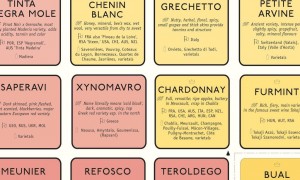 Remember studying the Periodic Table of the Elements in high school? You won’t need to struggle with Steve and Deborah De Long’s Wine Grape Varietal Table. A wine reference disguised as a fine-art print, it looks like the chemical table but replaces the elements with a world of wine grape varieties: 184 of the world’s favorite grapes organized by body and acidity, clearly showing how they relate. Buy one for a friend, or for yourself! The Wine Grape Varietal Table is $25. Click here to order now.
Remember studying the Periodic Table of the Elements in high school? You won’t need to struggle with Steve and Deborah De Long’s Wine Grape Varietal Table. A wine reference disguised as a fine-art print, it looks like the chemical table but replaces the elements with a world of wine grape varieties: 184 of the world’s favorite grapes organized by body and acidity, clearly showing how they relate. Buy one for a friend, or for yourself! The Wine Grape Varietal Table is $25. Click here to order now.
The De Longs also produce stunning, quality poster-size wine maps of France, Italy and other regions for $14.95 to $29.95. Click here to view and order any of the De Long wine maps.
Today’s Tasting Reports
Château de Poncie 2015 “Le Prê Roi” Fleurie ($20.99)
Clear, dark garnet, with reddish-orange glints against the light. Pleasant red-fruit aromas, subtle cherries and raspberries, are backed by a pleasant earthy sense of damp red clay. Delicious cherry-berry flavors are framed by surprising tannins for a Beaujolais and crisp, mouth-watering acidity and firm but not overwhelming 13.5 percent alcohol. A good wine that clearly shows the style of named-village Cru Beaujolais. U.S. importer: Henriot Inc., NYC. (Oct. 11, 2018)
FOOD MATCH: Fleurie makes a good match with poultry, particularly roast chicken or turkey; lighter-style pork dishes, cheeses and even more delicate pizza toppings. It was fine with a veggie pizza with onions and green peppers, mushrooms, green and black olives and banana peppers with rather light rations of cheese and tomato sauce.
WHEN TO DRINK: Conventional wisdom hold that Cru Beaujolais can evolve with cellar time, but as a practical matter, this 2015 is a good vintage, drinking well now. I wouldn’t hold it more than another year or two, other than as an experiment in cellaring.
VALUE:
Be prepared to pay a bit more for named Beaujolais Cru villages than standard Beaujolais, but this fine Fleurie is well worth Wine-Searcher.com’s $20 average retail or my $21 local price.
WEB LINK
This link will take you to a short fact sheet on Château de Poncie “Le Prê Roi” Fleurie, with following links to more detailed specifications.
FIND THIS WINE ONLINE:
Check prices and view vendors for Château de Poncie “Le Prê Roi” Fleurie on Wine-Searcher.com.
For an extensive list of other Fleurie producers and vendors, view this Wine-Searcher link.
Farmer’s Botanical Small Batch Organic Gin ($22.99)
Clear, watery pale with just a hint of buff color. If you’re used to the distinct juniper scent of more traditional gins, this American organic gin may surprise you: Juniper is there, but a pleasant soft citric vegetal scent of lemongrass dominates the scent for me, with earthy spicy notes of coriander seed and other subtle botanicals. It’s a bit warm on the palate at 93.4 proof, but its smooth, mellow character holds the heat under control and makes it an excellent mixer in negronis, martinis, gin and tonics or whatever you like. (Oct. 11, 2018)
VALUE:
I got a good deal compared with Wine-Searcher.com’s $30 average retail, but in the realm of artisanal gins, $30 is certainly a reasonable price.
WEB LINK
Don’t bother to click. At this point, the Farmer’s Gin website is limited to a single sentence, “The new Farmer’s Gin website is coming soon!”
FIND THIS DRINK ONLINE:
Find vendors and compare prices for Farmer’s Botanical Small Batch Organic Gin on Wine-Searcher.com.
Learn about gin and browse a list of brands and stores on this Wine-Searcher link.
More affordable wines
Want tips to more good, inexpensive wines? Here are Wine-Searcher links to vendors and prices for a bunch more wines for $10 or less that I’ve told you about during the past few months. Please tell us about your favorites!
Wine Forum and Social Media
If you have questions, comments or ideas to share about today’s article or wine in general, you’re always welcome to drop by our online WineLovers Discussion Group, the Internet’s first and most civil online community.
Discussions are open for public viewing, but you must register to post. If you’re a Facebook user, you can join our forum with a single click! All you need to do is visit the forum and click “Social Login” at upper right.
We’d also be delighted to have you visit and “Like” our WineLovers Facebook Page. This way you can get Facebook notifications when there’s a new The 30 Second Wine Advisor issue or a topic of particular interest on the WineLovers Discussion Group (WLDG).
Subscriptions and Administrivia
Unsubscribe:
We’re sorry if you must leave us, but simply click the “unsubscribe” link at the bottom of your Email edition to be instantly removed from the mailing list.
Change address:
The quickest and easiest way to change your email address is simply to unsubscribe from your old address and register again from the new one: Subscribe to The 30 Second Wine Advisor (free).
Archives:
Read nearly 20 years of past articles in the Wine Advisor Archives.
Sponsorship Opportunities:
For information, email Robin Garr at wine@wineloverspage.com

